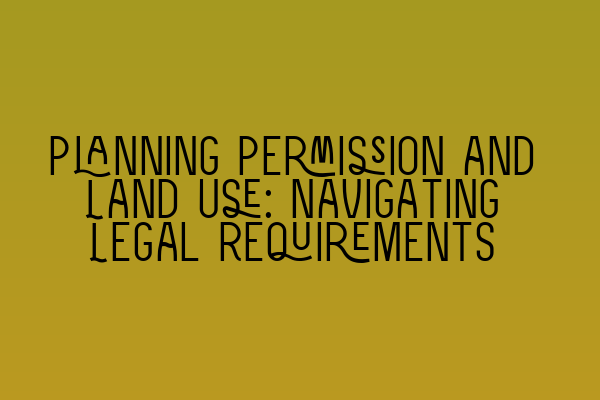Planning Permission and Land Use: Navigating Legal Requirements
In the realm of property law, planning permission and land use regulations play a pivotal role in ensuring the orderly development and effective utilization of land resources. Whether you are a property owner, developer, or an interested party, understanding the legal requirements and processes associated with planning permission and land use is crucial. In this article, we will delve into the intricacies of planning permission, explore the various legal considerations surrounding land use, and provide valuable insights to help you navigate these complex legal requirements.
What is Planning Permission?
Planning permission, also known as planning consent, is the legal authorization granted by local planning authorities for a proposed development or change in land use. It serves as a crucial regulatory mechanism to control and guide the use and development of land, ensuring that it aligns with broader planning policies and promotes sustainable development.
The Need for Planning Permission
Many types of development and changes in land use require planning permission. It is essential to obtain planning permission before commencing any development activities to avoid potential legal issues and financial penalties. Failure to secure planning permission can result in enforcement action, where local planning authorities can issue stop notices, enforcement notices, or even undertake legal proceedings to halt the unauthorized development or land use.
Types of Development Requiring Planning Permission
Various types of development require planning permission. These include:
1. New Buildings and Extensions: Constructing new buildings or extending existing structures usually require planning permission. This applies to both residential and commercial properties.
2. Change of Use: Changing the use of a property, such as converting a residential property into a commercial establishment or vice versa, typically requires planning permission.
3. Listed Buildings and Conservation Areas: Properties situated in listed buildings or conservation areas are subject to strict planning controls. Any alterations, extensions, or changes in land use usually require planning permission.
4. Demolition: Removing or demolishing a building may require planning permission, particularly if it is situated in a conservation area or is a listed building.
5. Signage and Advertisements: Certain types of signs and advertisements, especially those located in prominent positions, require planning permission. This ensures that they do not adversely affect the visual amenity of the area and comply with advertising regulations.
6. Land Development: Developing land, such as creating access roads, erection of fences, and landscaping, may require planning permission, depending on the specific circumstances and local planning policies.
Navigating the Planning Permission Process
Securing planning permission involves navigating a complex and rigorous process. It typically involves the following steps:
1. Pre-Application Consultation: Before submitting a planning application, it is advisable to engage in pre-application consultations with the local planning authority. This helps to clarify the planning policies, identify potential issues, and seek guidance on the application process.
2. Application Submission: The next step involves preparing and submitting a comprehensive planning application to the local planning authority. This includes detailed architectural drawings, planning statements, and supporting documents outlining the development proposal and its conformity with local planning policies.
3. Statutory Consultations: Upon receiving the planning application, the local planning authority may seek comments from various statutory consultees, such as highways authorities, environmental agencies, or heritage bodies. Their input and recommendations provide crucial insights into the planning merits of the proposed development.
4. Public Consultation: In certain cases, the local planning authority may require public consultation to gather opinions and feedback from the local community regarding the proposed development. This ensures transparency and allows stakeholders to express their concerns or support.
5. Decision-Making: The local planning authority assesses the planning application in light of local planning policies, statutory requirements, and consultation responses. They may grant planning permission subject to certain conditions, refuse the application, or request modifications to address any concerns.
6. Appeals and Judicial Review: If the planning application is refused or granted with unfavorable conditions, applicants have the right to appeal or seek a judicial review of the decision. However, it is crucial to seek legal advice before embarking on these processes to ensure a solid legal argument.
Legal Considerations in Land Use
Apart from planning permission, land use is governed by various legal considerations, including the following:
1. Zoning and Development Plans: Local planning authorities designate specific zones and prepare development plans to regulate land use. These plans outline the permitted uses, development standards, and objectives for each zone, guiding the development and use of land within their jurisdiction.
2. Covenants and Easements: Properties may be subject to restrictive covenants that impose limitations on land use. Easements, such as rights of way or rights of access, also play a crucial role in determining the permissible land uses and activities within a property.
3. Environmental Legislation: Various environmental laws and regulations govern the use of land to protect the natural environment. This includes regulations relating to conservation areas, protected species, pollution control, and sustainability requirements.
4. Health and Safety Regulations: Properties must comply with health and safety regulations to ensure the well-being of occupants and users. This includes adherence to fire safety codes, building regulations, and occupational safety standards.
5. Landlord and Tenant Laws: In cases of leased or rented properties, landlords and tenants must understand their respective rights and obligations regarding land use. This includes complying with lease provisions and seeking necessary permissions for alterations or changes in land use.
Conclusion
Navigating the intricate landscape of planning permission and land use in property law requires a well-informed approach. By understanding the legal requirements and processes associated with planning permission, as well as the broader legal considerations surrounding land use, you can ensure compliance with regulations and avoid potential legal pitfalls. Consulting with solicitors specialized in property law can provide valuable insights and guidance to help you successfully navigate these complex legal requirements.
Related Articles:
– SQE 1 Practice Exam Questions
– SQE 1 Practice Mocks FLK1 FLK2
– SQE 2 Preparation Courses
– SQE 1 Preparation Courses
– SRA SQE Exam Dates
